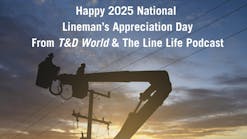Throughout North America, electric utilities have relied on helicopters for crew support, including landing employees on structures from helicopter platforms and performing long-line maintenance work. In addition, they have performed energized and de-energized transmission line work, including installing aerial marker balls, conductor spacers and line-marking devices; replacing insulators and hot-end hardware; making mid-span repairs; reconductoring; modifying towers; landing conductor carts; and repairing shield wire.
During the past three years or so, Western Area Power Administration’s Sierra Nevada Region (SN) linemen have been using the long-line helicopter method on a more frequent basis for constructing and maintaining power lines. Meanwhile, in the Rocky Mountain Region (RM), linemen have primarily relied on company Bell 407 helicopters to transport poles and materials on certain jobs that involved wrecking out or constructing transmission lines and equipment — until now.
In late August, Western had a one-week intensive helicopter training session for RM linemen duty stationed in Colorado, Nebraska and Wyoming. These linemen traveled to Laramie, Wyoming, to learn how to employ the long-line method when performing work on transmission lines. About two dozen RM linemen participated in the training, which was led by three qualified helicopter linemen from SN. These linemen shared their experiences and demonstrated long-line methods and techniques they use in the field.
Mastering the Manual
During the classroom portion of the training, the linemen reviewed Western’s Transmission Line Helicopter Maintenance Manual policies and procedures. Trainers instructed the linemen on applicable long-line method work procedures, basic responsibilities, emergency procedures, safety, job hazard analysis requirements, rules governing helicopter and pilot, and rescue procedures. At the end of the training, all participants were required to demonstrate that they had been satisfactorily trained on the applicable tasks outlined in the maintenance manual by successfully traveling to, landing on and departing from a wood H-frame structure.
A licensed professional helicopter pilot also participated in the training and spent time reviewing the rules governing helicopters and pilot responsibilities. He instructed the participants that all flight operations must comply with both applicable company policies and Federal Aviation Administration regulations. The pilot also ensured all participants understood the legal responsibilities a pilot has for the safety of the aircraft and the crew, and stressed that he is the final authority regarding the operation of that aircraft whenever flight operations were taking place.
Focusing on Field Training
Once the training was completed, RM linemen performed maintenance on 10 miles of transmission line outside Laramie using the helicopter long-line method to solidify their training and test its value in the field. The two-and-a-half-day field trial involved replacing overhead ground wire and fiber hardware on 115-kV wood H-frame structures.
During the trial, linemen extensively reviewed and practiced all applicable transmission long-line maintenance procedures and safety rules. Several job hazard analysis briefings also took place throughout the week to ensure every employee understood what is to be done and in what sequence, how it is to be done and by whom, possible hazards and how they are to be addressed, status of energy sources, PPE to use, and to stop work if changes in procedures or scope of the work took place. Emergency response procedures were also discussed.
Instruction also included understanding individual assignments, hazards and warning signs pertaining to safe helicopter operation, reviewing hand and head signals, checking handheld radios for proper operation and frequency, and ensuring all personnel were familiar with the aircraft operations. The pilot ensured that all personnel sending and receiving helicopter external loads at the landing zones were familiar with the operation of the aircraft belly hook and remote hook electrical and manual operations.
Linemen were taught to focus on how to appropriately inspect their long-line personal protective equipment (PPE) and incorporate a “buddy check.” The buddy check is an additional PPE safety review that uses a second or even third person to inspect a lineman’s PPE before that lineman is attached to the helicopter long line for transport.
Additionally, RM linemen were taught how to effectively communicate during helicopter operations. A visual tool linemen use for communicating with the pilot is to affix black electrical tape in a “+” pattern to the top of their helmets. The visual marking allows a lineman to use head signals to help the pilot position the lineman and equipment in the right place on the structure. A second means of communication is using handheld radios. Radios allow the workers to give clear and precise positioning instructions to the pilot. Participants were also taught if, at any time, communication between linemen and the pilot was lost, work would be immediately suspended until radio communication was re-established.
The field work more extensively covered the rules and work methods that govern helicopters and proper procedures for linemen when working around them on the ground. Particular attention was given to a helicopter’s approach and departure at the landing zones.
Looking Ahead
After the training session ended, Western had a lessons learned discussion with all of the training participants in attendance. The general consensus was the training and helicopter work method was a success and worth the time, expense and effort. Furthermore, every lineman who participated expressed the desire to incorporate using the long-line method for future work that takes place within RM.
Based on this training experience, RM plans to explore using the long-line method for future transmission line projects. Western continually strives to improve its business, technology and organizational excellence by finding new and better ways of doing business. Evaluating the helicopter long-line method is just one example of Western’s drive toward more efficient and effective operations and continuous improvement.
Western has opted to move to the long-line method for two key reasons — minimizing its footprint on the land and improving linemen’s safety and efficiency. For example, within Western’s geographic territory, linemen often face environmental and historic preservation concerns when operating vehicles and equipment across easements and sensitive lands. Within the past year, RM crews have worked around the newly federally protected sage grouse, listed on the National Register for Protected Species. In addition, RM line crews often encounter historical sites on easements such as the Oregon Trail, pioneer grave sites and tipi rings left behind by Native American tribes. Using helicopters reduces the impact to these sites and species as well as the surrounding natural resources by simply going over them.
Secondly, on certain projects, line crews can improve productivity and reduce costs by using the long-line method versus using aerial lifts and climbing structures. Linemen are exposed to safety hazards using conventional work methods and are more susceptible to injuries due to physical exertion and fatigue from excess climbing. Furthermore, many work locations are remote and may require hours of driving time resulting in exposure to motor vehicle accidents. Using helicopters will reduce some of the hazards associated with climbing and fatigue, and can also reduce the hazards associated with operating vehicles and equipment.
For now, RM will likely use the helicopter long-line method on a case-by-case basis. As time goes by, it may prove to be a very efficient and productive work method that is used on an ever-increasing number of projects. By training the field workforce how to work from a helicopter, Western is giving its crews a new skill set and, at the same time, boosting efficiency and reducing labor hours.
Will Schnyer ([email protected]) is a field maintenance manager for the field office in Cheyenne, Wyoming. He started his career with Florida Power & Light and has been in the electric utility industry since 1985. He currently serves as a Western Area Power Administration representative for the North American Transmission Forum and the Z359 Fall Protection Standards Committee.
Editor’s note: To see more photos of Western’s long-line work, visit www.flickr.com/photos/westernareapower/.
The Lowdown on Landing Zones
During the long-line helicopter training session, Western Area Power Administraion’s Rocky Mountain Region line crews learned the ins and outs of landing zones. Here are four tips for safely working with helicopters for line work.
1. Establish a landing zone that is three times the length of the rotor blades. A minimum of 60 ft is required for the smallest helicopter.
2. Make the landing zones as free, safe and secure as possible with only one lineman in charge of the landing zones and communicating with the pilot from the ground.
3. Select a smooth landing zone with a slope applicable to the make and model of the helicopter being used.
4. Identify and mitigate such hazards as tall brush, trees, fences, rocks, towers, poles, overhead wires, vehicles and public access to ensure safe landing zones.





